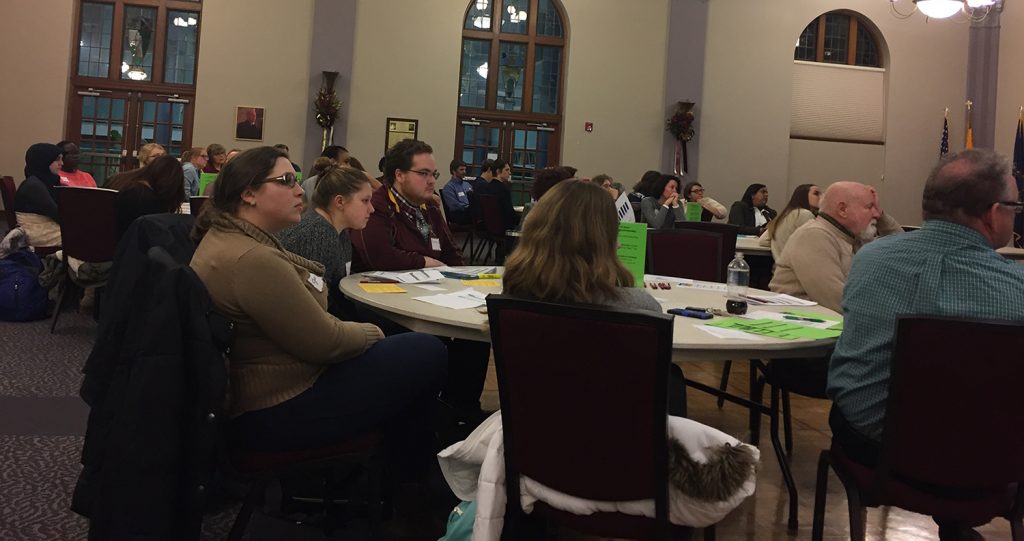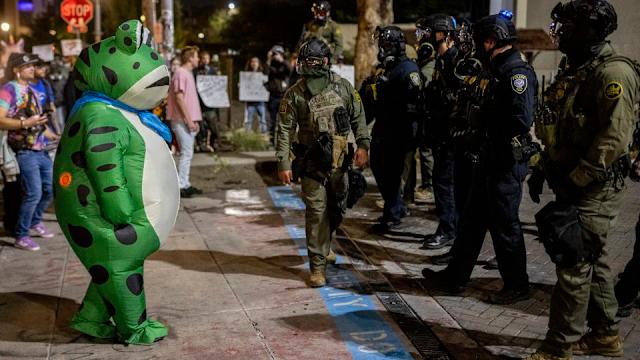Perhaps unsurprisingly, listening skills were one the focal points of the immigration discussion held in the Yehl Ball Room Thursday evening.
“We all do a good job of talking at each other and trying to get our opinions out, but we don’t listen,” Linda Fleming, Ph.D., the dean of the College of Humanities, Education and Social Sciences, said in her introduction for the event.
Although often understood as the subservient side of conversations, listening is just as important to understanding as expressing an opinion.
To encourage listening and discussion, Gannon faculty and staff teamed up with the Center for Social Concerns to design the event, where student facilitators led small groups of students and professors to think on issues like media literacy, national security and finance.
Anna Swick, a junior social work major and student facilitator, encouraged her group members to focus on using their own experience in discussion.
“Don’t worry about using the ‘correct’ PC language – it’s always changing,” Swick said. “Just try to use ‘I’ statements and avoid personal attacks.”
Kaustav Mukherjee, an assistant professor of English originally from Calcutta, demonstrated his own ‘I’ statement in Swick’s group.
“Immigration applies to me,” he said.
“I cannot ignore the ‘I,’ the ‘I’ is there. I am looking at it with my eyes.”
Students and faculty in attendance listened to short presentations from Jenny Catallier, Ph.D., Jeff Bloodworth, Ph.D., Garret Roth, Ph.D., and Chris Magno, Ph.D.
Fleming explained the discussion was not meant to talk about Trump’s immigration ban, but the United States’ perception of immigration as a whole, before the faculty presentations began.
Vaughn and Catellier talked about “fake news” and tips for educating oneself on informed media consumption. Bloodworth delivered a history of American immigration in seven minutes, while Roth offered a financial analysis on immigration. Magno finished the discussion with his thoughts on immigration in the context of national security.
The groups, led by student leaders, were then encouraged to talk about each topic amongst themselves for 10 minutes.
Carol Knoble, the director of Global Student Development and Engagement, said people’s perception of immigrants often depends on where they are coming from.
“We don’t notice them as much if they’re coming from [European countries],” Knoble said.
In Erie, immigrants have changed the population demographic in the last several years, but it is not reflected so deeply in the city’s infrastructure.
Emily Lion, a graduate student of English at Gannon and a teacher at Cathedral Preparatory School, said almost 30 languages are being spoken at any time in the Erie School District.
“Public education doesn’t work in a way to help students in the best way possible – which might contribute to the crime rate,” Lion said.
In his seven-minute history lesson, Bloodworth posed the final question: “How does a nation of immigrants stay true to its creed but address real security concerns?”
Mukherjee approached this question with the example of a rural farmer, who only knows of these issues through the media.
“It’s perfectly OK to have a fear of something,” Mukherjee said.
But Knoble looked for the root of that fear, arguing there’s a created fear around different cultures.
“It isn’t justified,” Knoble said.
Lindsay Brewster, a graduate English student and native of Arizona, talked about her thoughts on cultural differences. She gave the example of her father finding out one of their neighbors was an undocumented immigrant and how surprised he was.
“It was like, ‘you mean he’s not trying to ruin your life, dad?’” Brewster added sarcastically.
“A lot of this fear stems from oversimplifying everything.
“More people does mean more jobs; it just makes sense.”
KELSEY GHERING
[email protected]








